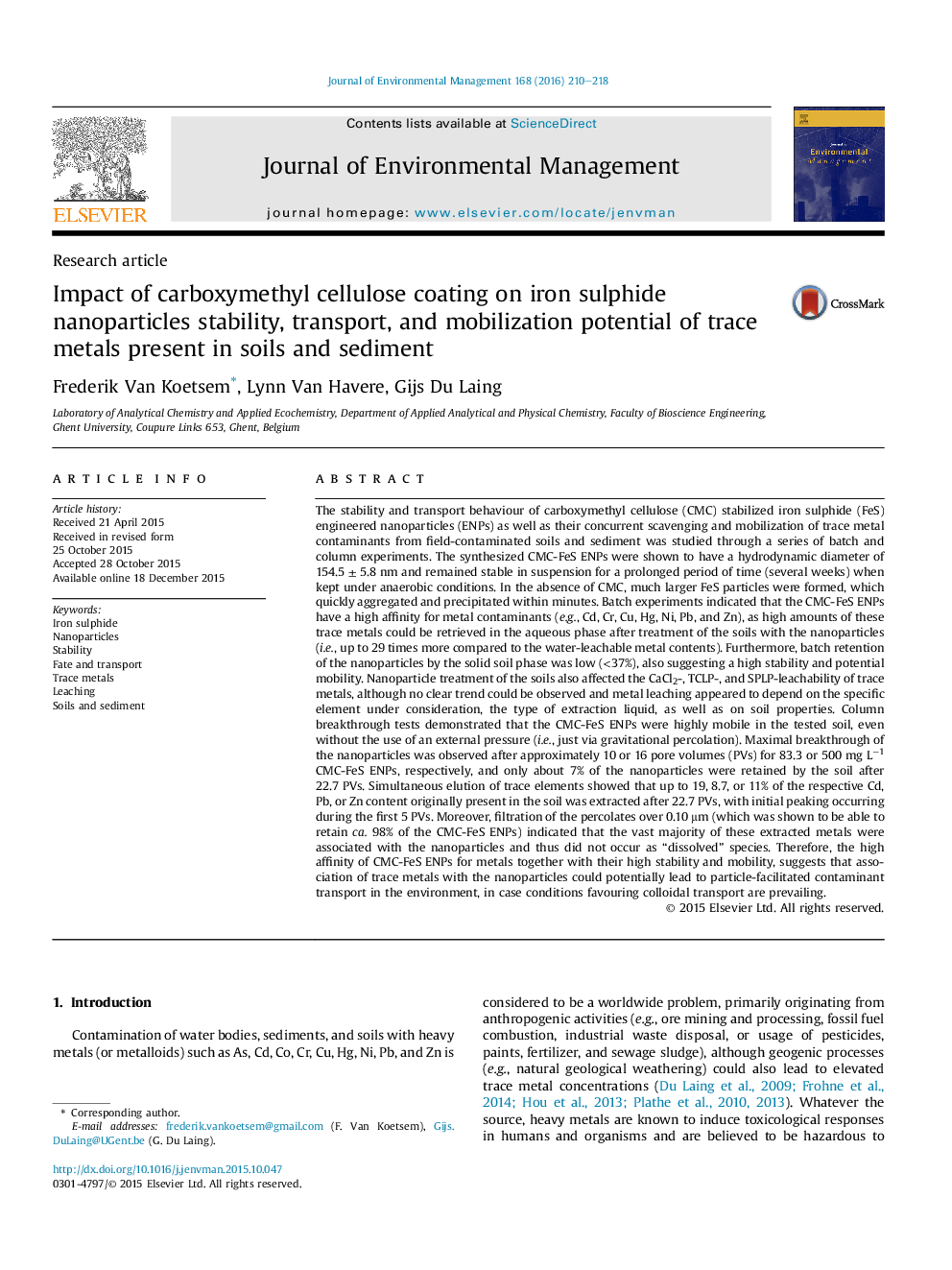| کد مقاله | کد نشریه | سال انتشار | مقاله انگلیسی | نسخه تمام متن |
|---|---|---|---|---|
| 1055560 | 1485244 | 2016 | 9 صفحه PDF | دانلود رایگان |
• The CMC stabilizer is a prime determinant of FeS ENPs size, stability and mobility.
• The synthesized CMC-FeS ENPs possess a high affinity for trace metal contaminants.
• The ENPs remain stable in suspension for several weeks under anaerobic conditions.
• Batch retention of the CMC-FeS ENPs by soil or sediment particulates was low.
• The CMC-FeS ENPs are highly mobile through a sandy soil column.
The stability and transport behaviour of carboxymethyl cellulose (CMC) stabilized iron sulphide (FeS) engineered nanoparticles (ENPs) as well as their concurrent scavenging and mobilization of trace metal contaminants from field-contaminated soils and sediment was studied through a series of batch and column experiments. The synthesized CMC-FeS ENPs were shown to have a hydrodynamic diameter of 154.5 ± 5.8 nm and remained stable in suspension for a prolonged period of time (several weeks) when kept under anaerobic conditions. In the absence of CMC, much larger FeS particles were formed, which quickly aggregated and precipitated within minutes. Batch experiments indicated that the CMC-FeS ENPs have a high affinity for metal contaminants (e.g., Cd, Cr, Cu, Hg, Ni, Pb, and Zn), as high amounts of these trace metals could be retrieved in the aqueous phase after treatment of the soils with the nanoparticles (i.e., up to 29 times more compared to the water-leachable metal contents). Furthermore, batch retention of the nanoparticles by the solid soil phase was low (<37%), also suggesting a high stability and potential mobility. Nanoparticle treatment of the soils also affected the CaCl2-, TCLP-, and SPLP-leachability of trace metals, although no clear trend could be observed and metal leaching appeared to depend on the specific element under consideration, the type of extraction liquid, as well as on soil properties. Column breakthrough tests demonstrated that the CMC-FeS ENPs were highly mobile in the tested soil, even without the use of an external pressure (i.e., just via gravitational percolation). Maximal breakthrough of the nanoparticles was observed after approximately 10 or 16 pore volumes (PVs) for 83.3 or 500 mg L−1 CMC-FeS ENPs, respectively, and only about 7% of the nanoparticles were retained by the soil after 22.7 PVs. Simultaneous elution of trace elements showed that up to 19, 8.7, or 11% of the respective Cd, Pb, or Zn content originally present in the soil was extracted after 22.7 PVs, with initial peaking occurring during the first 5 PVs. Moreover, filtration of the percolates over 0.10 μm (which was shown to be able to retain ca. 98% of the CMC-FeS ENPs) indicated that the vast majority of these extracted metals were associated with the nanoparticles and thus did not occur as “dissolved” species. Therefore, the high affinity of CMC-FeS ENPs for metals together with their high stability and mobility, suggests that association of trace metals with the nanoparticles could potentially lead to particle-facilitated contaminant transport in the environment, in case conditions favouring colloidal transport are prevailing.
Journal: Journal of Environmental Management - Volume 168, 1 March 2016, Pages 210–218
